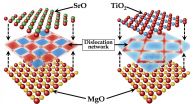(Press-News.org) DURHAM, N.C. -- Allowing polluters to buy, sell or trade water-quality credits could significantly reduce pollution in river basins and estuaries faster and at lower cost than requiring the facilities to meet compliance costs on their own, a new Duke University-led study finds.
The scale and type of the trading programs, though critical, may matter less than just getting them started.
"Our analysis shows that water-quality trading of any kind can significantly lower the costs of achieving Clean Water Act goals," said Martin W. Doyle, professor of river science and policy at Duke's Nicholas School of the Environment.
"All other things being equal, regulators should allow trading to occur at the river basin scale as an appropriate first step. Larger spatial scales may be needed later if abatement costs increase," said Doyle, who also serves as director of the water policy program at Duke's Nicholas Institute for Environmental Policy Solutions.
The new study was published this month in the journal Water Resources Research. It comes at a time when regulators are debating the optimal scales and types of trading programs to reduce water pollution in some of the nation's largest and most troubled watershed systems, including the Chesapeake Bay watershed, which spans 64,000 square miles in parts of six states.
In water-quality trading programs, facilities facing higher pollution control costs are allowed to meet their regulatory obligations by purchasing pollution reduction credits from other polluters in their trading market. The end result -- improved water quality -- is the same, but the time and money needed to achieve it is less.
New programs are often delayed because regulators want to get as many things right up front as they can. Concerns include how big or small a trading market should be, whether it should include interstate trading, and whether it should be based on one-for-one trades or trading ratios.
Getting these details right is vital, Doyle said, but it's also important not to let them bog down a program's launch.
"Our research very clearly shows that while achieving an optimal scale is best, any approach will yield gains over no trading at all," he said. "So the point is to allow trading."
To conduct their analysis, Doyle and his team developed a coupled hydrologic-economic model that measured the impacts of one-for-one trading and trading ratios among wastewater treatment plants in river basins draining into North Carolina's Albemarle-Pamlico Sound, the nation's second largest estuary. They assessed the pros and cons of each program type over the entire length of the basins, not just downriver or in the estuary. They also looked at how costs were affected when market scale was expanded from sub-basin to basin-wide, and then to a larger area that included adjacent basins extending into Virginia.
"As the markets got larger, facilities had more opportunities to find suitably sized trading partners who could help them reduce compliance costs," Doyle said. "But as we exceeded the basin scale, we reached a tipping point where risks increased so that pollution from many sources could end up in just a few places, creating pollution hotspots."
The study found only modest differences in the effectiveness of programs allowing one-for-one trading versus trading ratios. The optimal scales of markets remained the same under either scenario.
In addition to demonstrating that basin-wide trading is the optimal initial scale for many markets, the team's findings reinforce the need for interstate trading, Doyle said.
"Look at a map of the United States. If we are going to have water-quality trading here, we are going to have to allow interstate trading because of the geography of our states and river basins," he said. "Pollution doesn't start or stop at state borders."
Doyle is planning future studies to see if the same approach works for reducing non-point-source pollution from urban and agricultural runoff, which is a bigger problem in many river basins.
INFORMATION:
Funding for the new study came from the National Science Foundation (grants #CHN0909275 and #CHN 0908679) and from the Property and Environment Research Center. Coauthors were Lauren Patterson of Duke's Nicholas Institute; Yanyou Chen of Duke's Department of Economics; Kurt Schnier of the University of California at Irvine; and Andrew J. Yates of the University of North Carolina at Chapel Hill.
CITATION: "Optimizing the Scale of Markets for Water Quality Trading," Martin W. Doyle, Lauren Patterson, Yanyou Chen, Kurt Schnier, Andrew J. Yates. Water Resources Research, Sept. 11, 2014. DOI: 10.1002/2014WHR015395
Water-quality trading can reduce river pollution
Market for water quality credits would cut pollution at less cost
2014-09-23
ELSE PRESS RELEASES FROM THIS DATE:
State policies are effective in reducing power plant emissions, CU-led study finds
2014-09-23
A new study led by the University of Colorado Boulder found that different strategies used by states to reduce power plant emissions -- direct ones such as emission caps and indirect ones like encouraging renewable energy -- are both effective. The study is the first analysis of its kind.
The findings are important because the success of the Environmental Protection Agency's proposed Clean Power Plan depends on the effectiveness of states' policies in reducing power plants' carbon dioxide emissions. The plan would require each state to cut CO2 pollution from power plants ...
Big changes in the Sargasso Sea
2014-09-23
Over one thousand miles wide and three thousand miles long, the Sargasso Sea occupies almost two thirds of the North Atlantic Ocean. Within the sea, circling ocean currents accumulate mats of Sargassum seaweed that shelter a surprising variety of fishes, snails, crabs, and other small animals. A recent paper by MBARI researcher Crissy Huffard and others shows that in 2011 and 2012 this animal community was much less diverse than it was in the early 1970s, when the last detailed studies were completed in this region.
This study was based on field research led by MBARI ...
Study finds gallbladder surgery can wait
2014-09-23
LOS ANGELES – (September 23, 2014) –Laparoscopic cholecystectomy, a minimally invasive procedure to remove the gallbladder, is one of the most common abdominal surgeries in the U.S. Yet medical centers around the country vary in their approaches to the procedure with some moving patients quickly into surgery while others wait.
In a study published online Monday in the American Journal of Surgery, researchers found gallbladder removal surgery can wait until regular working hours rather than rushing the patients into the operating room at night.
"The urgency of removing ...
'Bendy' LEDs
2014-09-23
VIDEO:
This is an animation of the micro-rod growth process.
Click here for more information.
WASHINGTON D.C., Sept. 23, 2014 -- "Bendy" light-emitting diode (LED) displays and solar cells crafted with inorganic compound semiconductor micro-rods are moving one step closer to reality, thanks to graphene and the work of a team of researchers in Korea.
Currently, most flexible electronics and optoelectronics devices are fabricated using organic materials. But inorganic compound ...
Diabetes: Complexity lost
2014-09-23
WASHINGTON, D.C., September 23, 2014 -- For millions of people in the United States living with Type 1 or Type 2 diabetes, measuring the daily rise and fall of blood glucose (sugar) is a way of life.
Our body's energy is primarily governed by glucose in the blood, and blood sugar itself is exquisitely controlled by a complicated set of network interactions involving cells, tissues, organs and hormones that have evolved to keep the glucose on a relatively even keel, pumping it up when it falls too low or knocking it down when it goes too high. This natural dynamical balance ...
Future flexible electronics based on carbon nanotubes
2014-09-23
WASHINGTON, D.C., September 23, 2014—Researchers from the University of Texas at Austin and Northwestern University have demonstrated a new method to improve the reliability and performance of transistors and circuits based on carbon nanotubes (CNT), a semiconductor material that has long been considered by scientists as one of the most promising successors to silicon for smaller, faster and cheaper electronic devices. The result appears in a new paper published in the journal Applied Physics Letters, from AIP Publishing.
In the paper, researchers examined the effect ...
Lack of sleep increases risk of failure in school
2014-09-23
A new Swedish study shows that adolescents who suffer from sleep disturbance or habitual short sleep duration are less likely to succeed academically compared to those who enjoy a good night's sleep. The results have recently been published in the journal Sleep Medicine.
In a new study involving more than 20,000 adolescents aged between 12 and 19 from Uppsala County, researchers from Uppsala University demonstrate that reports of sleep disturbance and habitual short sleep duration (less than 7 hours per day) increased the risk of failure in school.
The study was led ...
Moving to the 'burbs is bad for business
2014-09-23
This news release is available in French. Montreal, September 23, 2014 — It's rare to see a Wal-Mart downtown. Big box stores usually set up shop in the suburbs, where rent is cheap and the consumer base is growing. So should smaller stores follow suit?
Not so fast, says Concordia University professor Tieshan Li. His recent study, published in the Canadian Journal of Administrative Sciences, shows that higher profits are had by retailers located furthest from where the market is expanding.
"Those results may seem counterintuitive but the decreased profits are ...
Los Alamos researchers uncover properties in nanocomposite oxide ceramics for reactor fuel
2014-09-23
Nanocomposite oxide ceramics have potential uses as ferroelectrics, fast ion conductors, and nuclear fuels and for storing nuclear waste, generating a great deal of scientific interest on the structure, properties, and applications of these blended materials.
"The interfaces separating the different crystalline regions determine the transport, electrical, and radiation properties of the material as a whole," said Pratik Dholabhai, principal Los Alamos National Laboratory researcher on the project. "It is in the chemical makeup of these interfaces where we can improve ...
Beating stress outdoors? Nature group walks may improve mental health
2014-09-23
ANN ARBOR, Mich. — They are common suggestions to remedy stress: You just need a breath of fresh air. Walk it off. Get out and see people.
Turns out all those things combined may in fact make you feel better – a lot better – a new large scale study suggests.
Group nature walks are linked with significantly lower depression, less perceived stress and enhanced mental health and well-being, according to the study conducted by the University of Michigan, with partners from De Montfort University, James Hutton Institute, and Edge Hill University in the United Kingdom. The ...
LAST 30 PRESS RELEASES:
How do birds flock? Researchers do the math to reveal previously unknown aerodynamic phenomenon
Experts call for global genetic warning system to combat the next pandemic and antimicrobial resistance
Genetic variations may predispose people to Parkinson’s disease following long-term pesticide exposure, study finds
Deer are expanding north, and that’s not good for caribou
Puzzling link between depression and cardiovascular disease explained at last: they partly develop from the same gene module
Synthetic droplets cause a stir in the primordial soup
Future parents more likely to get RSV vaccine when pregnant if aware that RSV can be a serious illness in infants
Microbiota enterotoxigenic Bacteroides fragilis-secreted BFT-1 promotes breast cancer cell stemness and chemoresistance through its functional receptor NOD1
The Lundquist Institute receives $2.6 million grant from U.S. Army Medical Research Acquisition Activity to develop wearable biosensors
Understanding the cellular mechanisms of obesity-induced inflammation and metabolic dysfunction
Study highlights increased risk of second cancers among breast cancer survivors
International DNA Day launch for Hong Kong’s Moonshot for Biology
New scientific resources map food components to improve human and environmental health
Mass General Brigham research identifies pitfalls and opportunities for generative artificial intelligence in patient messaging systems
Opioids during pregnancy not linked to substantially increased risk of psychiatric disorders in children
Universities and schools urged to ban alcohol industry-backed health advice
From Uber ratings to credit scores: What’s lost in a society that counts and sorts everything?
Political ‘color’ affects pollution control spending in the US
Managing meandering waterways in a changing world
Expert sounds alarm as mosquito-borne diseases becoming a global phenomenon in a warmer more populated world
Climate change is multiplying the threat caused by antimicrobial resistance
UK/German study - COVID-19 vaccine effectiveness and fewer common side-effects most important factors in whether adults choose to get vaccinated
New ultraviolet light air disinfection technology could help protect against healthcare infections and even the next pandemic
Major genetic meta-analysis reveals how antibiotic resistance in babies varies according to mode of birth, prematurity, and where they live
Q&A: How TikTok’s ‘black box’ algorithm and design shape user behavior
American Academy of Arts and Sciences elects three NYU faculty as 2024 fellows
A closed-loop drug-delivery system could improve chemotherapy
MIT scientists tune the entanglement structure in an array of qubits
Geologists discover rocks with the oldest evidence yet of Earth’s magnetic field
It’s easier now to treat opioid addiction with medication -- but use has changed little
[Press-News.org] Water-quality trading can reduce river pollutionMarket for water quality credits would cut pollution at less cost





